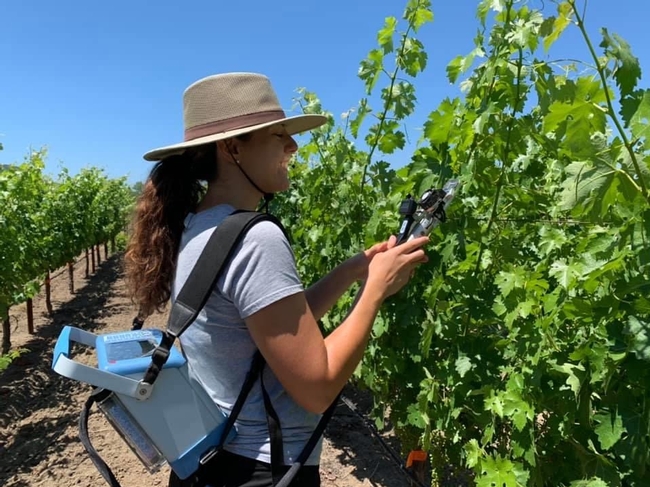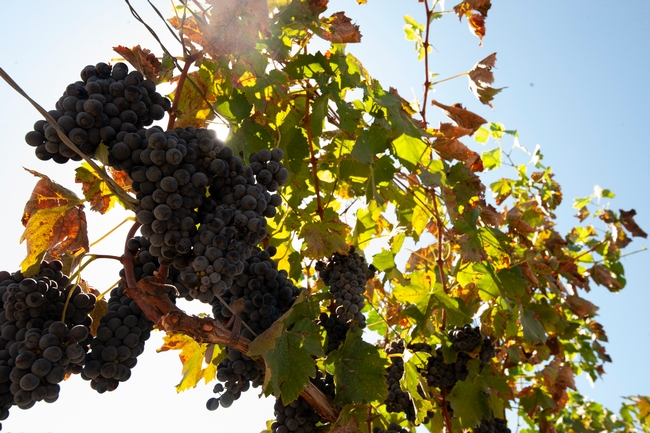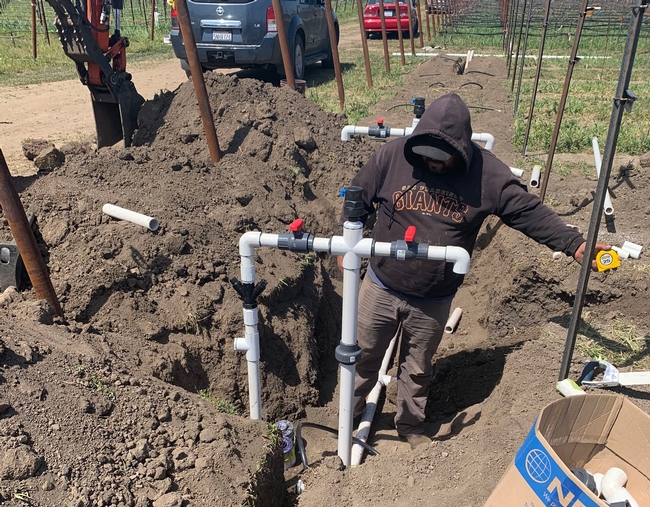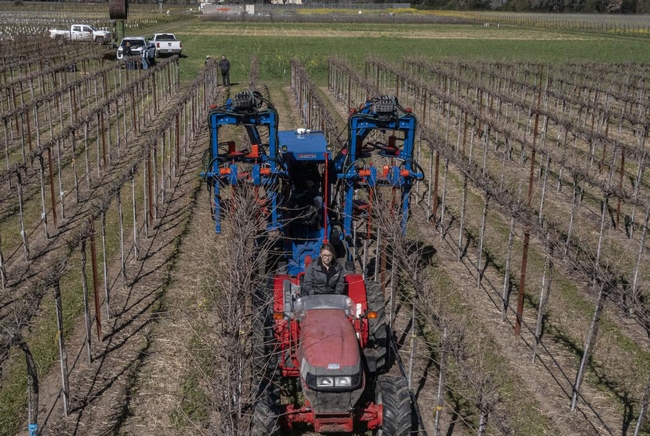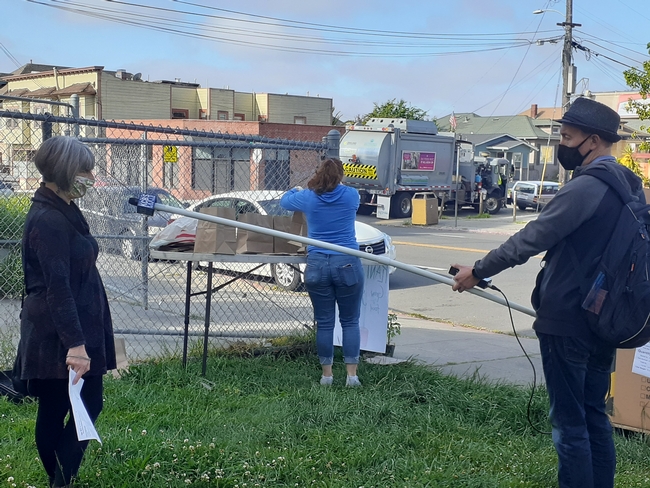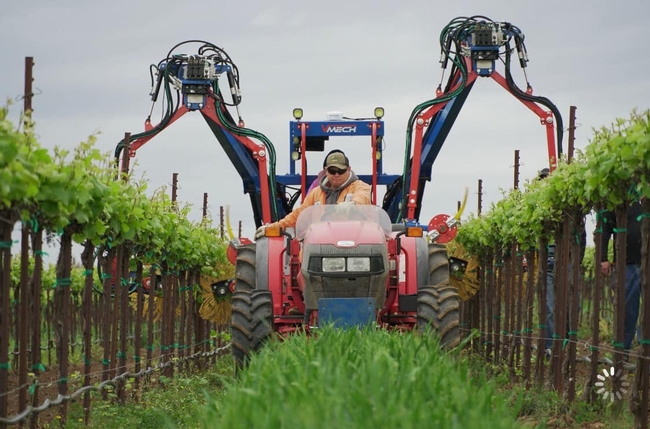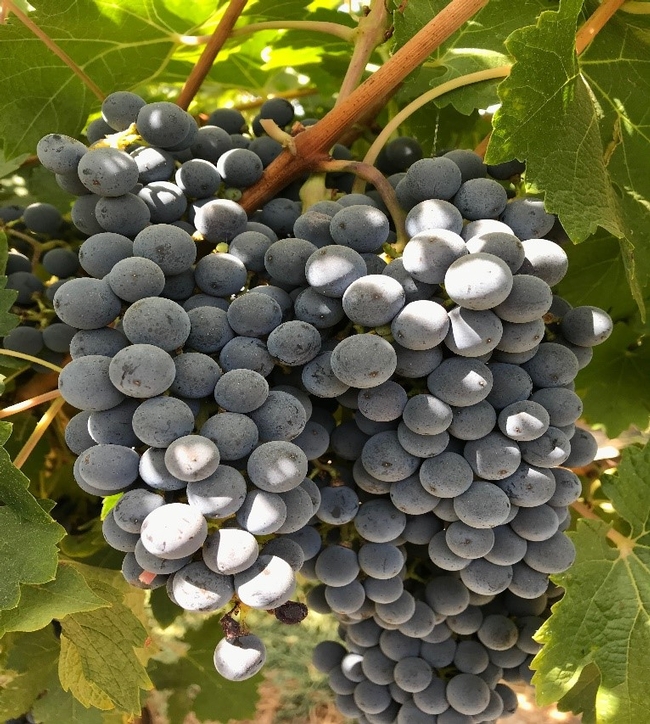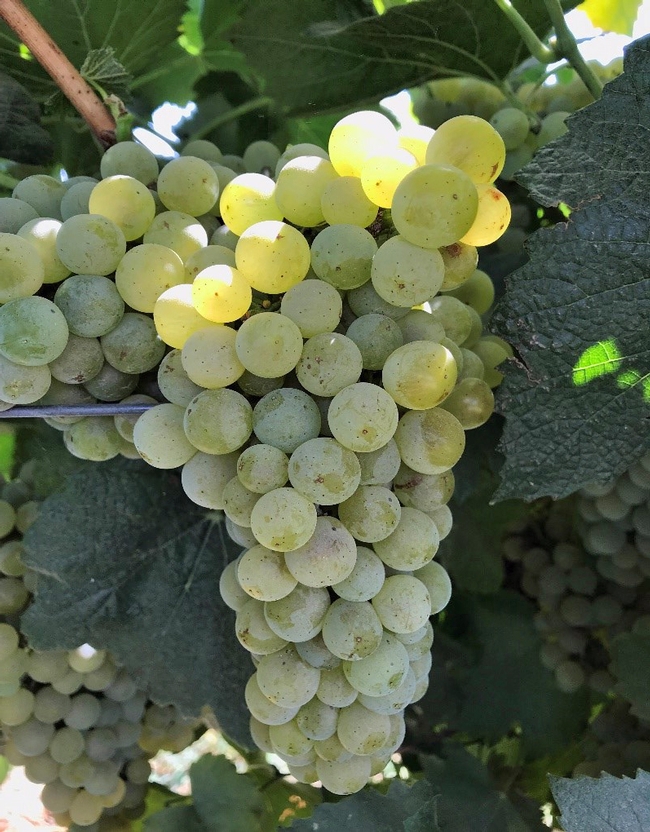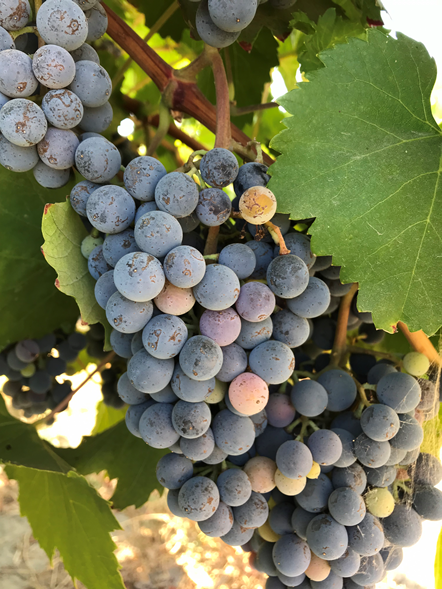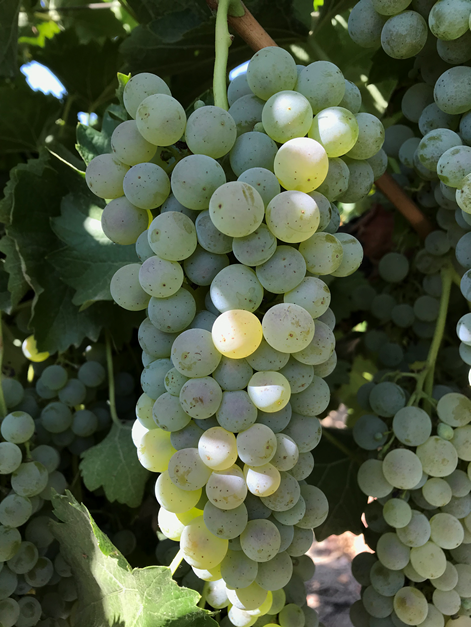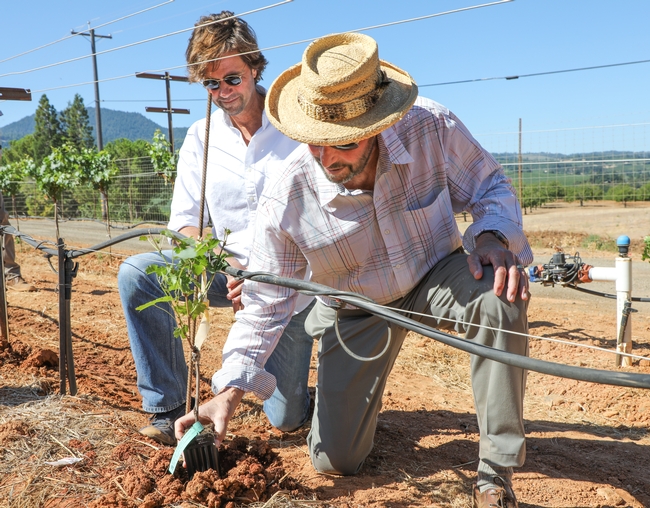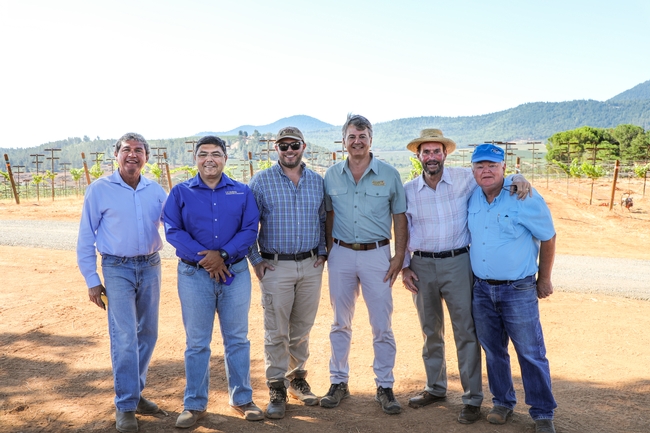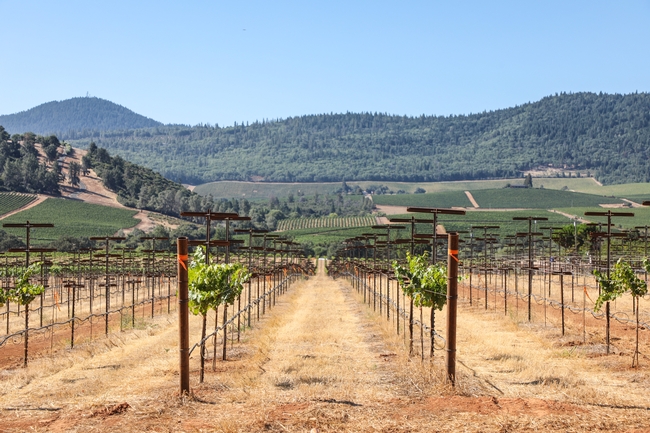Posts Tagged: Kaan Kurtural
Coastal grape growers can use less water during drought
Study finds using less doesn't compromise quality
California grape growers in coastal areas can use less water during times of drought and cut irrigation levels without affecting crop yields or quality, according to a new study out of the University of California, Davis.
The findings, published today (Sept. 1) in the journal Frontiers in Plant Science, show that vineyards can use 50% of the irrigation water normally used by grape crops without compromising flavor, color and sugar content.
It sheds new light on how vineyards can mitigate drought effects at a time when California is experiencing a severe water shortage and facing more extreme weather brought on by climate change, according to lead author Kaan Kurtural, professor of viticulture and enology and an extension specialist at UC Davis.
“It is a significant finding,” Kurtural said. “We don't necessarily have to increase the amount of water supplied to grape vines.”
Growers will also be able to use this information to plan for the next growing season. “Everybody's worried about what's going to happen next year,” he said.
Kurtural and others from his lab studied irrigation and cabernet sauvignon grape quality at a research vineyard in Napa Valley over two growing seasons, a rainy one in 2019 and a hyper-arid one in 2020.
They focused on crop evapotranspiration, which was the amount of water lost to the atmosphere from the vineyard system based on canopy size. The weekly tests used irrigation to replace 25%, 50% and 100% of what had been lost by the crop to evapotranspiration.
Researchers found that replacing 50% of the water was the most beneficial in maintaining the grape's flavor profile and yield. The level of symbiotic arbuscular mycorrhizal fungi, which help grapevines overcome stresses such as water deficits, was also not compromised. And the water used to dilute nitrogen application was also reduced, making the process more environmentally friendly.
The water footprint for growing grapes also decreased. For both the 25% and 50% replacement levels, water use efficiency increased between 18.6% and 29.2% in the 2019 growing season and by 29.2% and 42.9% in the following dry year.
While focused on cabernet sauvignon, most red grapes will respond similarly, he said.
“In the end, drought is not coming for wine,” Kurtural said. “There doesn't need to be a tremendous amount of water for grapes. If you over irrigate in times like these, you're just going to ruin quality for little gain.”
Members of Kurtural's lab — Nazareth Torres, Runze Yu, Johann Martinez-Lüscher and Evmorefia Kostaki — are also credited as authors.
University of California Agriculture and Natural Resources provided partial funding.
For more information, contact:
- Kaan Kurtural, Viticulture and Enology, skkurtural@ucdavis.edu
- Amy Quinton, UC Davis News and Media Relations, amquinton@ucdavis.edu
- Emily C. Dooley, College of Agricultural and Environmental Sciences, ecdooley@ucdavis.edu
Machines can help wine grape industry survive labor shortage
Wine grape growers in California and elsewhere face increasing labor costs and severe labor shortages, making it difficult to manage and harvest a vineyard while maintaining profitability. Growers are increasingly turning to machines for pruning, canopy management and harvesting, but how well these practices are executed can substantially affect yield and quality. A new review by researchers at the University of California, Davis, published in the journal Catalyst, provides guidelines for growers to make the best use of machines.
“Wine grape laborers have been virtually nonexistent. People don't want to work in vineyards anymore because it's remote, tough work,” said Kaan Kurtural, UC Davis professor of viticulture andenology andUC Cooperative Extension specialist. “There is now machinery available to do everything without touching a vineyard.”
Kurtural has designed a “touchless” experimental vineyard at the UC Davis Oakville Station to help growers understand how machines can help them cope with the labor shortage. While machines reduce the need for seasonal manual labor, they do not eliminate it. The degree of labor reduction depends on growing region, grapevine type and the number of practices growers mechanize.
The review provides guidance on using machines for winter pruning, canopy management and harvesting as well as how to design a grape vineyard for machines before planting. Videos showing the operation of different types of machinery and practices can also be found in the review.
Economic savings, quality grapes
About 90% of the wine grapes crushed in the U.S. are mechanically harvested. Previous studies have found about a 50% savings in labor costs from using machines to harvest instead of hand harvesting.
“Using more mechanization in a vineyard beyond just harvesting can also reduce labor costs without affecting grape quality.” Kurtural said.
Mechanical pruning, for example, can save between 60% to 80% of labor operation costs per acre compared to manual pruning alone. One experiment in the San Joaquin Valley, where more than 50% of California's wine grapes are grown, also showed using mechanical canopy management machines to manage merlot grapes resulted in twice the amount of color. The more color, or higher anthocyanin concentrations, the better the quality. It can significantly improve returns from vineyards in California's heartland.
Kurtural said there are machines available to manage canopies, including machines for leaf removal, shoot thinning and trunk suckering. Kurtural noted that the machines are American made, developed by researchers at the University of Arkansas and commercialized by manufacturers in Fresno and Woodland, California.
The review was co-authored by Matthew Fidelibus, UC Cooperative Extension viticulture specialist at UC Davis, based at UC Kearney Agricultural Research and Extension Center. Financial support for the research came from the American Vineyard Foundation and Bronco Wine Company.
Original post at https://www.ucdavis.edu/news/machines-can-help-wine-grape-industry-survive-labor-shortage.
ANR in the news April 16-30, 2020
Coronavirus's next victim: Big Meat
(Grist) Nathanael Johnson, April 30
“It's going to cause price spikes somewhere downstream,” said Rich Sexton, an agricultural economist at the University of California, Davis. But the average shopper might only notice empty shelves rather than higher prices, because “big grocery chains don't like to jack up prices, especially in times like this.”
…“There is going to be even more of a rush to automate farmwork and slaughterhouses,” Sexton said.
https://grist.org/food/coronaviruss-next-victim-big-meat/
As meat plants idle, California has no shortage of fish, dairy
(NBC News) Dennis Romero, April 29
…California produces about 20 percent of the nation's milk and has a large poultry processor in Foster Farms, but is otherwise dependent on the Midwest for pork and much of its beef, according to Daniel Sumner, director of the University of California's Agricultural Issues Center.
The state slaughters dairy cows for hamburger and raises calves for beef. But the 1-year-old livestock is sent to the Midwest for corn and soy feeding before being processed for beef there, he said. "We've never produced any hogs to speak of," Sumner added.
California producers fill nearly half the state's chicken and egg demand, he said.
https://www.nbcnews.com/news/us-news/meat-plants-idle-california-has-no-shortage-fish-dairy-n1194906
1-In-4 San Diegans Unemployed From Pandemic, North County Wants Businesses To Reopen, San Diego Sees Drop In Homelessness, And Online Learning Nightmare For Vets
(KPBS Midday Edition) Maureen Cavanaugh and Jade Hindmon, April 29
An estimated 25% of San Diegans are out of work because of the pandemic, according to a new SANDAG report. Plus, a handful of North County mayors want businesses in their towns to reopen sooner rather than later. Also, homelessness in San Diego is seeing a decline, according to the latest homeless count. Also, it's not just young students who are having a hard time with distance learning, veteran students are also dealing with the challenges of virtual classrooms. ... Finally, growing your own veggies? Some gardening tips from a master gardener. [UC Master Gardener Sommer Cartier discusses a new website to help gardeners https://www.mastergardenersd.org/lets-grow-together-san-diego/.]
https://www.kpbs.org/news/midday-edition/
Virus-related food shortages will be temporary in U.S., experts say
(Farm Press) Tim Hearden, April 29
…“Every economist agrees that the massive hit to the world economy and trade will likely cause millions of very poor people to be out of work and with no income,” said agricultural economist Daniel Sumner, director of the University of California's Agricultural Issues Center. “This is a consequence of the disease, but also of the policy of shutting down the economy.
“In poor countries, when the economy is shut down, the poorest people get even more hungry and people die, especially the kids,” Sumner said in an email.
'We're in pretty good shape' | Northern California unlikely to see meat shortage
(ABC10) Lena Howland, April 29
… Despite the ad Tyson Foods released over the weekend, saying the food supply chain in America is breaking, UC Davis Professor Daniel Sumner said we could expect to see some higher prices, but he doesn't expect to see shelves being wiped out anytime soon.
"If you want to have some very specialized meat product, you may find that in short supply in your local market on the day you're shopping, if you went back the next day, it may be there, but I don't think anybody has to worry about the supply chain in America, we're in pretty good shape," Sumner said.
And he said the only way we will see a shortage is if people panic buy, just like they did with toilet paper.
"As we've learned in the past month or two, you could certainly create a shortage in the sense that consumers can altogether if we all ran out and decided to stock up every freezer space that we have with steaks and pork chops," Summer said.
Nature And The Coronavirus: As Humans Continue Lockdown, Wildlife Creeps Back In
(On Point NPR) Brittany Knotts and Meghna Chakrabarti, April 29
Humanity in lockdown. Wildlife creeps back into cities around the world. We look at the pandemic from the animal kingdom's point of view.
Guests: Niamh Quinn, human-wildlife interactions advisor for the University of California Cooperative's South Coast Research and Extension Center. (@niamhnichuinn)
https://www.wbur.org/onpoint/2020/04/29/wildlife-coronavirus-animals-climate
Scientist at work: Trapping urban coyotes to see if they can be 'hazed' away from human neighborhoods
(Conversation) Niamh Quinn, April 29
After weeks of sleepless nights spent scrutinizing grainy images relayed from our remote cameras, mostly of waving grass and tumbling leaves, finally, there it is. A live coyote with a loop around its neck. On October 8, 2019, my colleagues and I caught the first member of the University of California Agriculture and Natural Resources pack, #19CU001.
Coronavirus: Should California brace for a meat shortage? Not exactly, say industry experts
(SF Chronicle) Esther Mobley, April 28
… There's not a shortage, exactly, say industry experts, though interruptions to the supply chain mean that it's taking a little longer than usual for meat to get from a farm to your grocery store shelf.
“We will have a short period where we have fewer packages of meat in the case,” said Daniel A. Sumner, director of the University of California Agricultural Issues Center. It will be an inconvenience, he said: “Let's say you like thin-cut pork chops, I like thick-cut pork chops. Well, one of us will be disappointed if we shop late in the day.”
Carbon Sequestration in Vineyards
(AgInfo) Tim Hammerich, April 27
...However, Extension Specialist Kaan Kurtural and his team at the Oakville Experiment Station are currently evaluating the impact cover crops can have on carbon sequestration in vineyards.
Kurtural…”Growers came to us. A couple of the questions they had was how can we sequester the carbon and how can we mitigate the amount of greenhouse gases we emit from the vineyards? So that was some background work done on it. Cover crops do sequester carbon and will store it in the soil. But as you till them, if you till the row middles, all this stuff is release back into the atmosphere. So we worked with a couple of private companies and we were able to get this new type of cover crop using a perennial system. Meaning that it doesn't have to be tilled or mowed, it just goes dormant. So we're comparing now till versus no-till systems using perennial and annual cover crops. So that's how that began.”
https://www.aginfo.net/report/45829/California-Ag-Today/Carbon-Sequestration-in-Vineyards
Covid-19 has forced large-scale farms that supply institutions to dump produce they can't sell. Why can't it just feed hungry people ? We've got answers.
(Counter) Lela Nargi, April 27
… To get a clearer understanding of where institutional food comes from, why kinks at the center of the supply chain make rerouting a challenge, and what's being done to change that, I talked to a variety of agriculture experts.
…Dr. Gail Feenstra, deputy director, Sustainable Agriculture Research and Education Program, University of California Davis: Our food system generally is built for global distribution. Now that's suddenly cracked, people are going back to more local food systems, where [important middle-tier components] like storage facilities [for meat and grain] aren't available.
…Feenstra: In California, some new food hubs are starting up to make the connection between small- and mid-scale famers with excess, and consumers who use CalFresh/SNAP. There's also work being done to figure out how to change CSAs to direct delivery or drop-off. Who is making these connections are co-op extension service agents, in every county in the U.S. They can share resources and research, and have access to grant monies. One agent told me she worked with county board supervisors to keep farmers' markets open, then with market managers to reorganize to keep the markets safe.
https://thecounter.org/covid-19-produce-dumping-food-banks/
COVID-19 outbreak causing possible meat shortage across US
(KRON4) Dan Thorn, April 26
…“That doesn't seem to be on the horizon yet… but we have had some disruptions,” Daniel Summer said.
Those disruptions, says Daniel Sumner — a U.C. Davis agricultural economist — will not create a shortage of meat.
Even after the country's largest meat producers including Tyson, along Smithfield and JBS have recently shuttered processing plants.
“You and I may see our favorite supermarket low on something but there will be plenty of meat –beef, pork and chicken that we all like there will be plenty of meat in the supermarkets,” Summer said.
https://www.kron4.com/news/bay-area/covid-19-outbreak-causing-possible-meat-shortage-across-us/
Marin farm sector struggles as virus cripples food services
(Marin IJ) Richard Halstead, April 26
… Randi Black, a University of California Cooperative Extension dairy adviser for Marin County, said, “We're kind of lucky where we are. We haven't been impacted quite as much as some of the eastern U.S. dairies have been. That's where we're seeing a lot of milk dumping.”
Black said that is because processors who buy Marin dairy farmers' milk sell most of their milk to grocery stores, while processors in the east rely more heavily on the food-services industry, which includes restaurants, hotels and airlines.
https://www.marinij.com/2020/04/26/marin-farm-sector-struggles-as-virus-cripples-food-services/
Want to save your citrus trees? Start a full-fledged insect war
(Los Angeles Times) Jeanette Marantos, April 25
…In citrus-loving California, some 60% of homes already have one or more citrus trees in their yard, said UC Riverside entomologist Elizabeth Grafton-Cardwell, director of the Lindcove Research and Extension Center in Exeter. (That's a statewide average, with fewer in Northern California and more in Southern California, she said.)
…But Mark Hoddle, a biological control specialist at UC Riverside, sees things differently. Hoddle and his entomologist wife, Christina Hoddle, also at UC Riverside, went to Pakistan in 2010 looking for natural enemies of the Asian citrus psyllid, and there they found Tamarixia radiata, tiny parasitoid wasps that lay their eggs on the backs of psyllid toddlers (a.k.a. nymphs).
https://www.latimes.com/lifestyle/story/2020-04-24/how-to-save-your-citrus-from-hlb-disease
Even as new technologies revolutionize farming, not everyone has access
(Sac Biz Journal) Emily Hamann, April 24
Technology could hold the key to solving growers' issues both around labor and water.
George Zhuang, a farm adviser with the UC Cooperative Extension, works with wine grape growers in the Fresno region, where machines have largely taken over the job of growing grapes.
“Most newly established vineyards go to 100% mechanization,” Zhuang said.
Amid rising costs and limited availability, farmers struggle to find enough workers
(Sac Biz Journal) Emily Hamann, April 24
…Wine grapes are known for being especially labor intensive. Grape harvesters have been commonplace in vineyards in the San Joaquin Valley for decades, but vines still needed maintenance, including pulling leaves and trimming shoots, by hand. Now that's changing as well, said Kaan Kurtural, viticulture specialist at the UC Davis.
…“We have a lot of consolidation in our business,” Kurtural said. “Vineyards are getting larger as farmers are getting old and their kids don't want to do this anymore, so they're selling their holdings.”
A Strained Food Chain
(Health in all Matters) Michael Joyce, April 24
COVID-19 has drastically disrupted the way food is produced, distributed, and available in the U.S. and around the world. The toll of the virus on those who plant, pick, buy, sell, and, at times, go hungry, is increasing. In this episode, we explore the vulnerabilities of a complex and interconnected food system and the inevitable bright spots along the way.
Guest: Daniel Sumner
https://podcasts.apple.com/us/podcast/a-strained-food-chain/id1503590411?i=1000472557618
Farmers face new challenges in their ongoing quest for water
(Sac Biz Journal) Emily Hamann, April 24
…“Almond trees are actually pretty resilient,” said Katherine Jarvis-Shean, a Sacramento-area orchard farm advisor with the University of California Cooperative Extension.
While the trees themselves can live through a drought year, insufficient water will reduce yields for the present season and seasons into the future, Jarvis-Shean said.
But this year growers can also rely on groundwater pumped from wells drilled into a patchwork of underground aquifers.
“One year with low precipitation is not a problem with groundwater,” Jarvis-Shean said. “The problem is if we continue to have dry winters.”
Protecting The Valley's Vulnerable Populations From COVID-19
(KVPR) Kathleen Schock, April 24
COVID-19 is disproportionately hurting vulnerable communities like seniors, ag workers and the homeless. To learn about efforts to protect these at-risk populations, FM89's Kathleen Schock spoke with Lisa Blecker, pesticide safety education program coordinator for the UC Division of Agriculture and Natural Resources, Laura Moreno, chair of the Fresno Madera Continuum of Care, and Kristen Beall Watson, CEO of the Kern Community Foundation.
https://www.kvpr.org/post/protecting-valleys-vulnerable-populations-covid-19
Too celebratory for a pandemic, California's farmed oysters and caviar lose their markets
(San Francisco Chronicle) Janelle Bitker, April 24
…California's aquaculture industry, which includes farmed trout, clams and mussels in addition to higher-end abalone and oysters, represents about $200 million in annual sales, according to Jackson Gross, an aquaculture specialist at UC Davis.
…“Are people willing to pay for a premium local product?,” Gross said. “They're doing that at restaurants, but they're getting the frozen stuff from the big chain stores.”
Stop stable flies from biting into profits
(Progressive Dairy) Julia Hollister, April 23
It only takes five stable flies biting on the front legs of a cow to reduce weight gains and milk yields, according to Alec Gerry, a University of California – Davis veterinary entomology specialist.
Gerry, who spoke at the 2020 Golden State Management Conference in Modesto, California, has been researching flies for over 25 years. His most recent studies are in collaboration with researchers at the Veterinary Medicine Teaching and Research Center in Tulare, California.
https://www.progressivedairy.com/topics/herd-health/stop-stable-flies-from-biting-into-profits
In The Quiet Of Sheltering In Place, Have You Encountered Wildlife Differently?
(KPCC ) Larry Mantle, April 23
As the quarantine continues, residents surrounding Griffith Park have shared that they're noticing more wildlife activity - hawk nests, deer in the hills, opossums on the roads.
According to the Los Angeles Times, some wildlife biologists are saying what's changed isn't animal behavior but our own. We finally have the time and the patience to notice the wildlife around us.
GUEST: Niamh Quinn, human-wildlife interactions advisor with the University of California's Cooperative Extension, a branch of the UC system which researches local issues; she tweets @niamhnichuinn
Oakland Schools Use Gardening to Help Families
(KCBS radio) Matt Biglar, April 23
Canned food... diapers... tomato plants?
As KCBS Radio's Matt Bigler reports, Oakland schools are helping families get food and supplies and also get into gardening.
The plant giveaway came out of the Contra Costa Master Gardeners spring fundraiser, which unfortunately withered and died this season.
“But with the shelter in place order, we were unable to hold our plant sale.” Dawn Kooyumjian said, they decided to donate their seedlings to nearly 50 organizations, including Oakland Unified.
“People are able to come, pick up their necessities that the school district is providing, and also take home a vegetable plant that will allow them to have a little bit of food security in their home.
https://kcbsradio.radio.com/media/audio-channel/oakland-schools-use-gardening-to-help-families
The Great Potato Giveaway
(NPR) Stacey Vanek Smith, April 23
…Daniel Sumner is an agricultural economist at the University of California, Davis. He says the problem boils down to two things.
DANIEL SUMNER: How streamlined and specialized things are.
...SUMNER: The farmer will be linked directly to the restaurant customers and grow for that restaurant in San Francisco or New York City or somebody growing exactly the kind of lettuce that McDonald's needs for their hamburgers. That's been a great system.
https://www.npr.org/2020/04/23/843437140/the-great-potato-giveaway
Lockdown silver linings: For a Sacramento family, baby chickens bring meaning, solace
(Sac Bee) Diana Williams, April 22
…Imagine my delight in stumbling across a backyard chicken census online. It's overseen by Maurice Pitesky, a veterinarian and epidemiologist at the UC Davis School of Veterinary Medicine-Cooperative Extension.
Pitesky's best guess is there are about 100,000 backyard flocks in California. Sacramento probably has about 11 percent of them, making ours the third-highest backyard chicken region in the state, behind Los Angeles and San Francisco.
https://www.sacbee.com/entertainment/living/article242190746.html
Volunteer program donates over 30,000 plants to community gardens in Contra Costa
(KRON4) Omar Perez, April 21
A volunteer program donates thousands of vegetable plants to local undeserved communities in the Bay Area free of charge. Over the last few weeks volunteers for The Contra Costa Master Gardeners Program donated more than 30,000 plants to local school and community gardens.
…“Because of COVID-19 they were not able to have the sale so they quickly decided they would distribute the plants for free to local communities, elderly and schools,” Bay Area Program Director Frank McPherson said.
Coyotes, falcons, deer and other wildlife are reclaiming L.A. territory as humans stay at home
(LA Times) Louis Sahagun, April 21
Similarly, research scientist Niamh Quinn, who serves as human-wildlife interactions advisor for UC Cooperative Extension, said none of the five collared coyotes she is studying in the cities of Hacienda Heights, Roland Heights, La Verne and Chino Hills “have changed their behavior yet.”
“I do believe, however, that human behavior has been altered significantly by the lockdown in ways that are closing the gap between us and what's wild around our own homes — and that's great, up to a point,” she said.
She worries that animals may be pushed into closer conflicts with humans. “We have to interact with wildlife from a distance. That is because we still do not know all the diseases that, say, coyotes and rats carry with them.”
https://www.latimes.com/environment/story/2020-04-21/wildlife-thrives-amid-coronavirus-lockdown
A century later, victory gardens connect Americans again
(AP) Kristin M, Hall, April 21
… Creating a victory garden now can be, as it was during World Wars I and II, a shared experience during hardship and uncertainty.
“World War I, to me, is a pretty stark parallel,” said Rose Hayden-Smith, a historian and author of “Sowing the Seeds of Victory: American Gardening Programs of World War I.” “Not only was there a war, but there was an influenza pandemic.”
… “So these gardening posters and food preservation posters would appear in literally dozens of languages,” said Hayden-Smith....“We don't have poster art, but we have Instagram,” she said.
Empty Grocery Shelves and Rotting, Wasted Vegetables: Two Sides of a Supply Chain Problem
(Inside Climate News) Georgina Gustin, April 19
"In terms of resilience and nimbleness, they seem to be able to pivot and figure out new supply chains quickly," said Gail Feenstra, deputy director of the University of California-Davis Sustainable Agriculture Research and Education Program (SAREP). "They're always struggling because of the competition that comes from the global food system. It puts many of them at a disadvantage. But now that system is in complete disarray. It allows these regional food systems to emerge. They're the ones that are bringing relief to communities."
… "This is more than a dress rehearsal. This is it," said Feenstra, of UC-Davis, referring to the disruptions caused by the pandemic. "This is going to be here for a while and it isn't the last time this will happen. This is an opportunity for our policy makers to invest in small and mid-scale businesses."
Is your tree on death's door? Here's how to tell
(LA Times) Jeanette Marantos, April 19
Climate change, invasive species and even international trade are taking a serious toll on California trees. An estimated 150 million trees died during the drought that started in December 2011, according to Smithsonian Magazine, and the stressed trees that survived became more vulnerable to attack by a host of newcomer pests, said Philippe Rolshausen, subtropical tree specialist for the Cooperative Extension office at UC Riverside.
"There are lots of invasive pests everywhere because of global warming and the movement of plant materials in general," he said.
Fresh Produce and Milk Go to Waste Even as People Need Food Amid Coronavirus Pandemic
(KQED Forum) Michael Krasny, April 16
Even as food banks are seeing more demand than ever, some California farmers are dumping milk and letting produce rot. The coronavirus pandemic has disrupted how we eat and in turn, how food is distributed. The closure of many restaurants, venues, and schools is leaving many food suppliers with excess perishables. Meanwhile, retailers and food banks are scrambling to keep food in stock. We talk with experts about how California's food supply chain has been disrupted, how it's adapting, and what to expect in the months to come.
Guests: Dan Sumner, professor of agricultural and resource economics, UC Davis
UC releases new cost studies for mechanized winegrape production
New studies provide details about trellis type, planting density, cost and potential benefit of vineyard mechanization
UC Agriculture and Natural Resources' Agricultural Issues Center has released four new studies detailing the costs and returns of wine grape production in the southern San Joaquin Valley. All four cost studies illustrate the cost and benefit of nearly full mechanization on wine grape production.
The studies estimate the cost of establishing a vineyard and producing wine grapes, focusing on four wine grape varieties – Cabernet Sauvignon, Chardonnay, Rubired and Colombard.
“Those studies take into consideration mechanical pruning, leafing, shoot thinning, and harvest on a typical wine grape vineyard with the average production level for this region,” said George Zhuang, UC Cooperative Extension viticulture advisor in Fresno County.
“With farming labor becoming more scarce and expensive, growers will opt to transition into more mechanization,” Zhuang said. “These studies provide detailed information about the trellis type, planting density, cost and potential benefit of vineyard mechanization. Based on these studies, fully implemented mechanization reduces the production cost from $3,000 to $2,500 per acre and that represents 17% cost reduction. This information will ultimately help growers to guide their production practices to more profitable and competitive ways under the new era of farming labor.”
Wine grape growers should look at the costs, particularly expenses associated with mechanization, Zhuang said.
“The investment to purchase and own equipment can be high,” Zhuang said. “Fortunately, it is easy to find a contractor in this region to perform certain vineyard tasks, if the initial investment to purchase equipment is prohibitive.”
Numerous studies, including UC studies, have confirmed the benefits of vineyard mechanization to grape and wine quality with lower production costs.
“It is a win-win-win situation,” Zhuang said. “Growers can improve their farming margins, wineries and juice processing plants can get reliable and higher quality grapes and juice from farms, and average consumers can enjoy better wine and more healthy grape products at an affordable price.”
The studies are based on 200-acre farms with the vineyard established on 40 acres using two types of trellis systems – quadrilateral cordon system and bilateral cordon system. In addition to regular grape production expenses – such as irrigation, fertilization and pest control – the researchers broke out the differences between machinery costs and hand labor hours required for thinning, pruning and harvesting for each variety.The prices for labor, materials, equipment and custom services are based on October 2019 figures.
The California minimum wage law will gradually decrease the number of hours employees can work on a daily and weekly basis before overtime wages are required. For more information and to view the California minimum wage and overtime phase-in schedules visit aic.ucdavis.edu.
Input and reviews were provided by UC Cooperative Extension farm advisors, specialists, grower cooperators and other agricultural associates. The authors describe the assumptions used to identify current costs for wine grape establishment and production, material inputs, cash and non-cash overhead. A ranging analysis table shows profits over a range of prices and yields.
The new studies are:
- 2019 - Sample Costs to Establish and Produce Winegrapes in the Southern San Joaquin Valley – Chardonnay Variety
- 2019 - Sample Costs to Establish and Produce Winegrapes in the Southern San Joaquin Valley –Cabernet Sauvignon Variety
- 2019 - Sample Costs to Establish and Produce Winegrapes in the Southern San Joaquin Valley – Rubired Variety
- 2019 - Sample Costs to Establish and Produce Winegrapes in the Southern San Joaquin Valley – Colombard Variety
All four winegrape studies can be downloaded from the UC Davis Department of Agricultural and Resource Economics website at http://coststudies.ucdavis.edu. Sample cost of production studies for many other commodities are also available on the website.
For additional information or an explanation of the calculations used in the studies, contact Donald Stewart at the Agricultural Issues Center at (530) 752-4651 or destewart@ucdavis.edu.
For information about local grape production, contact George Zhuang, UCCE viticulture advisor for Fresno County, at gzhuang@ucanr.edu; UCCE viticulture specialist Matt Fidelibus at mwfidelibus@ucanr.edu; UCCE viticulture specialist Kaan Kurtural at skkurtural@ucdavis.edu; Karl Lund, UCCE viticulture advisor for Madera, Merced and Mariposa counties, at ktlund@ucanr.edu; or Gabriel Torres, UCCE viticulture advisor for Kings and Tulare counties, at gabtorres@ucanr.edu.
To save cabernet from climate change, UC studies rootstock and clone combinations
UC Cooperative Extension, Beckstoffer Vineyards and Duarte Nursery are launching the wine industry's most ambitious cabernet sauvignon rootstock and clone trial in the Red Hills of Lake County to give the varietal greater resilience to climate change.
Cabernet sauvignon is California's second top-selling varietal by volume, just behind chardonnay.
“We have been growing cabernet sauvignon since the 1970s, and we are very proud to be part of this trial, which will help improve cabernet sauvignon growing for years to come,” said Andy Beckstoffer, owner and CEO of Beckstoffer Vineyards, which is providing the land and labor for the project.
The industry-driven trial – “Climate-smart Solutions for Cabernet Sauvignon Production” – includes 3,600 vines with 10 cabernet sauvignon clones on 10 rootstocks.
“This trial will give us data that will help inform and improve growing practices for cabernet sauvignon across the state for the next two decades,” said the trial's lead researcher, S. Kaan Kurtural, UC Cooperative Extension viticulture specialist at UC Davis Department of Viticulture and Enology and Oakville Experiment Station.
While the experimental vineyard is in Lake County at a property known as Amber Knolls, the data will be analyzed in Oakville.
The trial officially launched Aug. 15 in Kelseyville with a celebratory vine planting as Andy Beckstoffer and son David Beckstoffer planted the vine that also marked a milestone – the 1.5 millionth vine for Beckstoffer Vineyards Red Hills. Researchers, industry representatives and journalists gathered to celebrate what is affectionately known as “the mother of all cabernet trials.”
“Everything is wonderful in Lake County – for growing cabernet sauvignon and for doing research,” Andy Beckstoffer said, noting the Lake County region's ongoing support for farming.
Pedro Rubio, Beckstoffer Vineyards Red Hills general manager, said, “Lake County will definitely benefit, but the results from this trial will be very helpful for the whole industry.”
Designed to address resiliency in a changing climate, the trial will examine which combinations give the best results with a focus on drought tolerance and water-use efficiency as well as crop yield and grape quality.
“The idea behind the trial is to gain further insights into the interactive effects of rootstock selections crossed with cabernet clones and the impact of that on water relations and overall sustainability,” said Clint Nelson, ranch manager for Beckstoffer Vineyards Red Hills.
“The trial will give us an understanding of the synergistic relationship of clone and rootstock and what combination drives the best quality and production,” he said.
According to Nelson, the trial will look at canopy architecture, yield components, water relations, traditional fruit chemistries, secondary metabolites such as aroma, mouthfeel and color, as well as overall vine performance.
Duarte Nursery is providing all of the planting material for the trial.
“The diversity of rootstocks and clones chosen for this project includes some of the most modern cabernet sauvignon clones designed for high quality and for production,” said John Duarte, nursery president.
Duarte said the trial is employing a lot of cutting-edge technology and using some of the cleanest plant materials available to prevent grapevine viruses.
“Planting a vineyard with pristine nursery stock initially really extends the life of that vineyard,” Duarte said.
Viticulture has become more data-driven, and this trial will measure a staggering amount of data generated by the 100 or so rootstock-clone combinations over the approximately eight to 10 years of the trial's duration.
“Nothing of this scope has been attempted,” said UC Cooperative Extension specialist Kurtural, who acknowledged logistics as the biggest challenge with planning, data collection and timely analysis being at the forefront of his mind. “It keeps me up at night.”
Planning for the length of the project also is a concern. The vineyard will be planted this year and the first crop will be harvested in 2021. It will take at least six years to begin to see consistent results.
Kurtural said the project will provide research opportunities in academic and applied science for at least two students to complete work toward a doctoral degree in horticulture and agronomy.
Glenn McGourty, UC Cooperative Extension viticulture advisor for Lake and Mendocino counties, is a research collaborator on the project.
“Lake County obviously has an important role to play in fine wine in the North Coast, particularly for cabernet sauvignon,” McGourty said. “And this trial really marks the importance of this location in terms of the commitment and the collaboration that we see here among both public and private sectors.”
About Beckstoffer Vineyards: Named “Napa's most powerful grape grower” by both the Wall Street Journal and Wine Spectator, Beckstoffer Vineyards was founded in 1970. Beckstoffer Vineyards is firmly rooted in the soil of Northern California's wine country, with Andy Beckstoffer playing an integral role in the evolution of the wine grape industry since 1970. Joined at the family-owned business by his son David in 1997, they share a common mission – to produce the highest quality grapes in Northern California that form the foundation for exceptional wines – and a combined passion for the land and viticulture expertise. Beckstoffer Vineyards first acquired land in the Red Hills in 1997, which after subsequent acquisitions, today totals nearly 2,000 planted acres across three blocks: Amber Knolls Vineyard, Crimson Ridge Vineyard, and Amber Mountain Vineyard.
About Duarte Nursery: Duarte Nursery, Inc. (DNI) is a family-owned and operated nursery and the largest permanent crops nursery in the United States.

